We at Carpey Law go to great lengths to make sure you know the causes and statistics of accidents so that you may avoid them on the road. If you are new to motorcycles, or if you are interested in a review of the tenets of good riding, give this article a read. Here, we cover the fundamentals of braking, group riding, staying visible, and riding at night. Save it, print it, bookmark it: It may help to keep you and others safe.
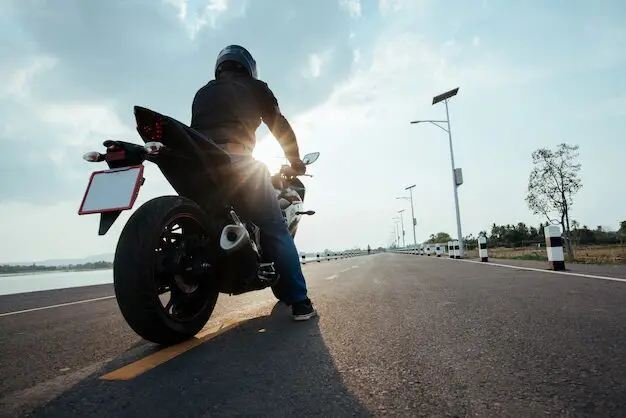
The Alarming Statistics-
According to the U.S. National Highway Traffic Safety Administration (NHTSA), 5579 motorcyclists died in 2020.
While in 2021, we only have NHTSA’s estimates for the number of motorcycle fatalities in the first 9 Months. The data estimates a significant increase in casualties in the first three quarters as compared to the number of fatalities reported in the first 9 months of 2020.
Let’s be honest. No motorcyclist who comes across this article is going to suddenly have an epiphany about the risks associated with motorcycles and retire from their days riding, and that’s O.K. The purpose of this article isn’t to try and persuade motorcycle enthusiasts to give up their passion. Rather, it is intended to inform the public on precautionary measures riders should take to avoid being a part of the aforementioned statistic.
This article discusses:
- Can Riding A Motorcycle Be Safe?
- What Percentage Of Motorcycle Riders Get Into Fatal Accidents?
- What Are The Ways to Protect Yourself from Motorcycle Injuries?
- Why Motorcycle Training Courses In PA Are Vital to Safe Biking?
- How to Ride a Motorcycle Safely in Pennsylvania?
- How To Improve Visibility And Motorcycle Safety On The Road?
- How To Share the Road with Motorcycles?
If you or your loved ones are suffering from a Motorcycle Accident, Contact Carpey Law
Can Riding A Motorcycle Be Safe?
When it comes to riding a motorcycle, there really is no way to ride 100 percent risk-free. Just like driving a car, there are many factors that you oversee to ensure your safety, but there are also several factors that you cannot control that always impose at least a little bit of risk. Furthermore, the more irresponsible an individual is on a motorcycle, the more likely they are to experience an accident. Therefore, riding a motorcycle can be infinitely safer if the motorcyclist takes proper precautions to avoid an accident.
For instance, if the motorcyclist takes affirmative actions on the road to make sure that other drivers can clearly see them and improve their overall visibility can substantially decrease the chance of an accident. Additionally, wearing the proper safety gear, including helmets, jackets, pants and boots, all work to prevent motorcycle accidents or decrease the chance of injury or death if an accident does occur. Finally, obeying traffic laws and riding defensively, especially in poor weather or in heavy traffic, can exponentially increase the safety of riding a motorcycle.
What Percentage Of Motorcycle Riders Get Into Fatal Accidents?
Fatal car accidents happen every day, but statistics clearly show that motorcyclists make up a remarkable proportion of vehicular fatalities.
As per NHTSA, motorcyclists’ risk of a fatal crash is 28 times greater than a passenger car, with an 80% chance of serious injury or death resulting from an accident.
To some degree, these statistics can be explained simply by the nature of riding a motorcycle. Motorcyclists are at a greater risk of injury or death because they are not surrounded by a vehicle designed to mitigate the impact resulting from an accident and protect the passengers. Additionally, due to their small size, motorcycles are more likely to be missed by other drivers or hidden in blind spots.
What Are The Ways to Protect Yourself from Motorcycle Injuries?
Many states have motorcycle safety laws that enforce the use of personal protective equipment (PPE), but not all. PPE has four main functions that prove vital to a rider’s safety. Wearing this equipment allows for improved visibility (so that other drivers can see you), abrasion resistance, impact protection, and weather protection.
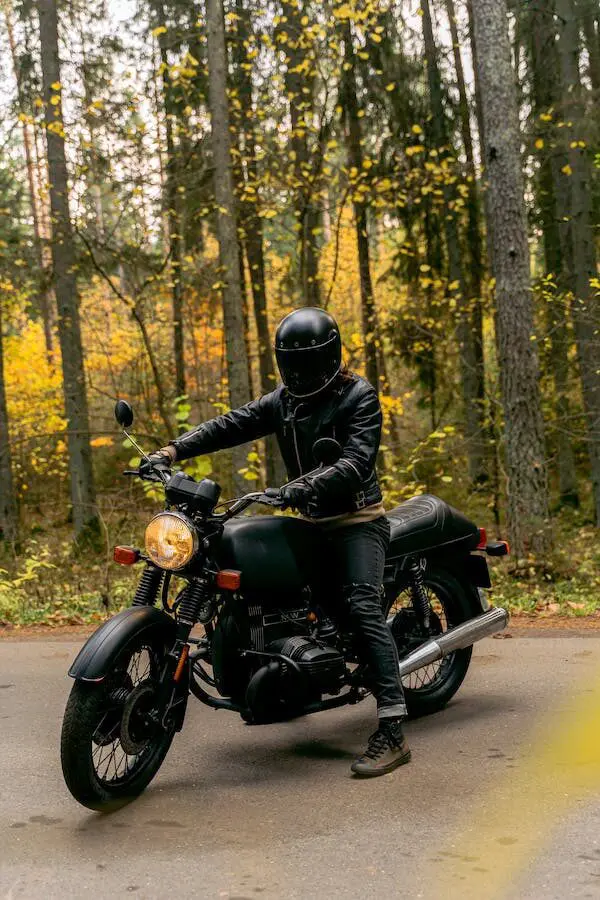
What sort of protection should I wear while riding my motorcycle?
Some gear you should seriously consider:
- Helmet — A Department of Transportation (DOT) certified full-face helmet is the absolute best idea for every cyclist. A full-face helmet provides the most protection, however, 3/4- and 1/2-helmets also are available. It is also important to always keep your helmet fastened while driving. Your helmet should be a good fit for you personally: try out different brands and different sizes until you find one that is both snug enough not to shift and loose enough not to place too much pressure on your ears or forehead.
- Gloves — Commonly made of leather, cordura, or Kevlar, or some combination. Gloves designed specifically for motorcycle use have slightly curved fingers and the seams are on the outer surfaces to allow the motorcyclist to maintain his grip and control on the handlebars and clutch/brake levers. Some gloves also provide protection to the wrist.
- Jackets — Most jackets include special padding on elbows, spine and shoulders. Airbag system technology is now available fitted to jackets and vests for accident protection and impact protection for both riders and pillions.
- Pants — Made of the same material as jackets, usually including special protection for the knees and hips. You cannot go wrong with leather. It is the safest material when sustaining a fall from your bike—safer than denim, nylon and even Kevlar.
- Boots — Especially those for sport riding, include reinforcement and plastic caps on the ankles, and toe area. Boots designed for cruiser-style riders often have steel-reinforced toes (However this reduces sensitivity of the foot when changing gear). Boots should always have a rubber sole (as opposed to leather or other less-flexible materials).
- Goggles or Helmet Visor — Your eyes can be extremely vulnerable while riding. Eye protection is of utmost importance – an insect or a kicked-up pebble in the eye at speed has enough momentum to cause significant damage. For this reason, you should have adequate eye protection. Make sure to have a shield on your helmet or a strong set of goggles. A windshield on your bike does not count as sufficient eye protection.
- Ear plugs — Most riders experience substantial wind noise at speeds above 40 to 50 mph (64 to 80 km/h). Ear plugs help protect against hearing damage, and reduce fatigue during long rides.
- Vests — Made with high-visibility colors and retroreflective materials, vests can be worn over jackets to increase the chance of being seen and allow drivers to better judge the speed and position of riders, especially in adverse conditions of dark and wet.
Why Motorcycle Training Courses In PA Are Vital to Safe Biking?
One of the most effective motorcycle training course programs you can take is hosted by the Motorcycle Safety Foundation’s, with 2,700 locations all over the country. In Pennsylvania, there are about 807,444 registered motorcyclists.
The risks of motorcycles are self-evident. They lack safety features common in cars and trucks, like protective frames, leaving riders vulnerable in the event of accidents. One of the best measures you can take to increase your safety on a motorcycle is to attend and graduate from motorcycle training courses.
First of all, many insurance companies offer discounts (sometimes as much as 10 – 15 percent) for riders who have graduated from motorcycle training courses. Not to mention that your premiums may be reduced if you have a record of no-violations. A motorcycle training course, which is free for Pennsylvania residents, can help you to keep your driving record spotless. It will teach you the importance of helmets, safety gear, common accidents, and so much more. It will make a better, safer rider.
How Much Does The Motorcycle Safety Course Cost?
When it comes to finding a motorcycle safety course, there are many options in Pennsylvania. One of the best options is a course offered by the PennDOT called the Pennsylvania Motorcycle Safety Program, which is free for all Pennsylvania residents. The Program offers two beginner courses and two advanced courses, so riders of all experience levels can learn about motorcycle safety in Pennsylvania. For non-Pennsylvania residents who are interested in the Motorcycle Safety Program, you can still attend by paying a minimal fee of $100-$250, depending on the course the individual wishes to take.
Pennsylvania Motorcycle Safety Program (PAMSP) provides motorcycle safety training courses through several motorcycle training third-parties.. Interested candidates should contact the approved training provider closest to their location. Click here to see a full list of course locations in Pa. Over 6 million Americans have graduated from the course, and the benefits are far-reaching.
Carpey Law encourages all motorcycle riders to register themselves in some form of motorcycle training course to help keep all drivers safe. But until your classes begin, start your education now by reading the many motorcycle accidents articles and motorcycle lawyer articles on our website.
Learn More about Motorcycle Laws in PA
How to Ride a Motorcycle Safely in Pennsylvania?
With summer weather at its peak, it is the perfect time of year for men and women to jump on their motorcycles and ride. But a motorcycle ride, while fun and exhilarating, can be a dangerous endeavor if not approached safely. Whether you’re a beginner or a veteran motorcyclist, it’s never a bad idea to review some of the more useful tips for riding your bike safely. The following is a brief list of important points to bear in mind while preparing to ride your motorcycle this summer. Remember that exercising caution on your motorcycle will help keep the roads safe not just for you but for others as well.
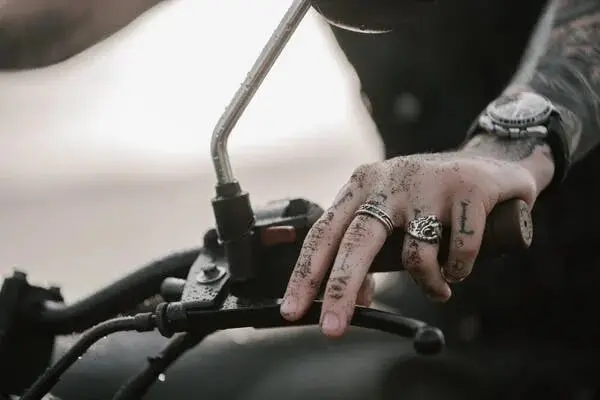
What is the Safest Way to Apply the Brakes on My Motorcycle?
You should mostly apply the brakes as a means to slow down—rarely should you use the brakes to come to an abrupt stop as this can cause your bike to skid. Of course, sometimes you may have no choice but to skid and lay the bike down. In general, you should engage the front and rear brakes at the same time.
- It is a general rule of thumb that, when moving at speeds over 20 MPH, you should apply around 75% of your front brakes and about 25% of your rear brakes on dry roads.
- On wet roads, the ratio is more like 50%/50%. It is also important to remember that you should apply the brakes as a means to slow down and not to come to a sudden stop. Safely braking on a motorcycle is a careful skill that takes practice to master.
- You should also remember not to apply the brakes on a curve unless it is necessary. Since you are leaning while taking a curve, pressing the brakes can be potentially hazardous. However, if you must do so, press lightly, especially in areas of low speed limits and sharp turns. If a motorcycle is going too fast, the tires could lose the grip needed to make the turn. Furthermore, you should always look ahead while taking a turn, never down.
- The coefficient of friction (or coefficient of traction) represents the amount that you are able to accelerate or brake on a given surface while maintaining your tire’s grip on the road. If you apply the brakes too hard, you may cause your tires to “lock-up,” which means they no longer spin and, instead, slip along the surface of the road. The coefficient of friction is also determined by the condition of the road. Dry roads have an increased coefficient of friction while wet roads have a decreased coefficient of friction.

Proceed with Caution when Applying the Brake on Wet Roads
You must exercise more caution on a slippery surface. For example, you will use the front brake less than on a dry surface, making the front/rear brake ratio about 50%/50%. Be aware: Even if it has not rained, morning dew can cause roads and painted road markings (like traffic lane indicators, crosswalks, and stop bars) to be very slippery. On a wet road, the coefficient of friction is significantly decreased, which makes it easier for your tires to slip. Always increase your braking distance on wet roads, and lightly apply your brakes every now and then just to test their grip on the road surface.
Remember! Keep in mind that the first minutes of a rain storm are the most dangerous for riders. There is a good deal of oil in the road and, when it rains, the oil is brought to the surface, which increases the potential for slippage. As the rain continues to fall, however, the oil is washed away. For this reason, if you must ride in the rain, try to wait a while: even though the road will still be wet, the road oil will have had time to clear out.
What should I know before taking a passenger on my motorcycle?
When you take a passenger with you on your motorcycle, you must be prepared for the extra weight. This weight affects the way your bike handles, takes a turn, and brakes.
Things to remember when riding with a passenger:
- Your passenger should wear the same quality protection that you wear.
- Your passenger should hold tightly to you throughout the ride.
- When taking a turn, your passenger should lean with you.
What is the Correct Procedure when Riding with other Motorcyclists (group riding)?
- When participating in a group ride, you should always try to ride with bikers who possess a skill set similar to your own. If riding with three or more people, you should not ride beside another bike but adopt a staggered formation, with the first bike on the left side of the lane and the second bike on the right side of the lane, and so on.
- Staggered Formation: Furthermore, you should remember to always obey the “2-second rule,” which stipulates that you should maintain a 2-second distance from the biker directly ahead of you, and a 1-second distance from the biker on the left or right of you. That way, should anything obstruct the road or cause a disturbance in the ride, you will have time to react accordingly.
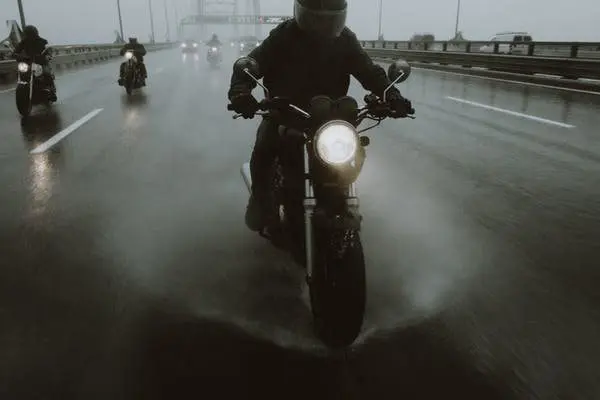
Is it Safe to Ride My Motorcycle at Night?
Riding your motorcycle is certainly less safe at night than it is during the day, but it is often necessary.
- To help you remain visible in the darkness, you should try and wear bright or reflective clothing.
- Since there is always a higher risk at night of crossing paths with wildlife like deer, it is a good idea to drive slower than you would during the day.
- Headlights: You should also make sure your headlights are working properly and your windshield is clean. It also helps to pay attention to the lights of the car ahead of you—these lights can indicate the condition of the road ahead. For example, a bouncing tail light can mean that there are bumps or potholes in the road.
- Remember! Your single headlight can often blend in with the other headlights on the road, making it hard for other drivers to see you right away. Bear in mind that drivers may sometimes need an extra moment or two to notice you.
Contact Our Motorcycle Accident Lawyer
How To Improve Visibility And Motorcycle Safety On The Road?
There are undeniable components to riding a motorcycle that increase the risk of injury or a collision. Many would agree that riding a motorcycle requires the driver to regulate more variables than an individual who drives a passenger vehicle. These additional components can not only be more physically or mentally taxing for a motorcyclist, but also create more opportunities for a mistake to occur that has dire consequences for the rider.
Having said that, the real “danger” that is often associated with riding a motorcycle usually stems from extraneous factors that are either out of control of the motorcyclist or were the direct result of the motorcyclist making irresponsible decisions on the road. For example, weather can be a contributing factor that affects how dangerous a motorcycle can be.
Additionally, poor decisions from the motorcyclist can also increase the risk of riding a motorcycle, such as failing to wear a helmet, speeding or driving under the influence of alcohol.
While you cannot always control how other drivers behave on the road, a motorcyclist is always able to control how safely he or she rides. Perhaps the best thing that a motorcyclist can do to ride a motorcycle safely is to ride in a manner that improves their visibility to other drivers on the road. This means that the motorcyclist avoids riding in the blind spots of cars or tailgating. Many individuals recommend that motorcyclists should drive under the assumption that other drivers cannot see them to encourage safe driving practices. Here’s what you can do to be seen on the road and around large vehicles.
Be Seen on the Road
Did you know that the most common motorcycle accidents involve a car or truck driver claiming they did not see the motorcycle? This is why it is of the utmost importance that you do your best to be seen on the road, both during the day and the night.
Some tips to help you be seen on the road:
- You should use your headlights at all times. Even during the day, use of headlights can help to make your presence known to other drivers.
- Wear bright colors as often as possible.
- Flash your brakes before you slow down. This is especially important if someone is tailgating you.
Be Seen Around Large Vehicles
Riders should exercise caution around large trucks or other vehicles as a motorcycle can easily slip into a large vehicle’s blind spot. Do not try to pass unless you are sure the truck is not going to change lanes. If you do pass, do not linger next to the truck for very long.
Another way people can ride motorcycles safely is to drive defensively. Driving defensively means that you ride with heightened caution. In other words, defensive driving means that the motorcyclist adheres to all traffic laws, ensures space between their bike and other traffic, and properly signals for every turn.
Furthermore, motorcyclists can ride a motorcycle safely by being familiar with the bike and having a strong understanding of the bike’s handling and capabilities. This level of understanding of a motorcycle helps ensure that the driver will be able to exert control over the motorcycle.
Finally, wearing the proper safety gear is another element of safely riding a motorcycle. Wearing a helmet to protect the rider’s head and jackets or pants that prevent road rash are all designed to protect motorcyclists in severe and minor motorcycle accidents. Exercising all these precautions while operating a motorcycle can help ensure that you safely arrive at your destination.
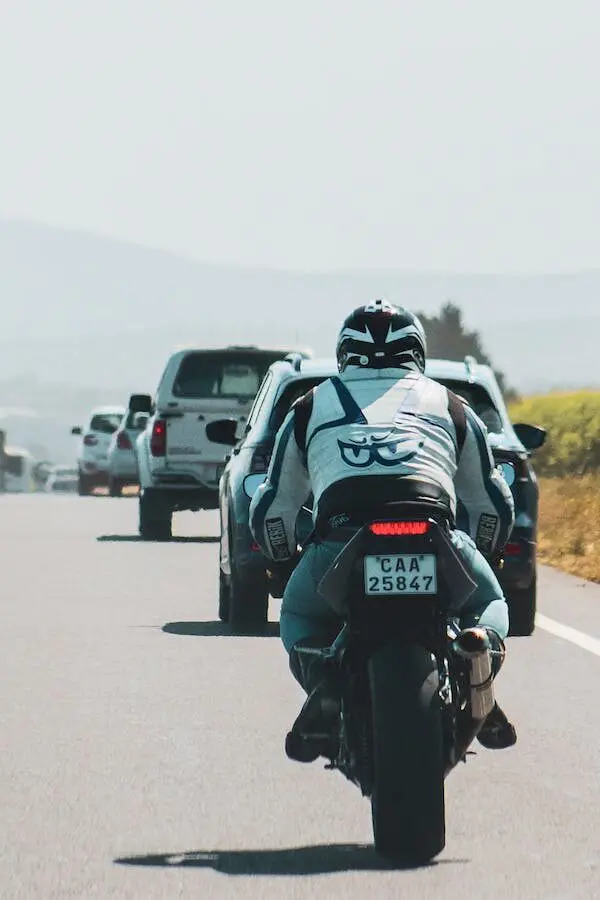
How To Share the Road with Motorcycles?
Motorcycle riders are as vulnerable as bicyclists. A motorcycle does not have the same protection as a car. There is no external frame, seatbelts or bumpers to shield them and sometimes they can be difficult to see.
- Be watchful. Motorcycles are easy to miss in traffic. Learn to watch for the narrow profile of a motorcycle. Be careful when you park your car and when opening your car door into the street after parking. While the operator of a motorcycle must be on the lookout for a car door opening, so too must the person opening the car door into a lane of traffic. Opening a car door into a lane of traffic is considered a violation of the Pennsylvania Vehicle Code.
- Operating a motor vehicle while distracted is one of the single most frequent causes of not-seeing a motorcyclist. Distractions include texting, speaking on a cell phone. Be watchful for such distractions while driving on the road.
- Pay extra attention at night. You can easily misjudge distance due to a motorcycle’s single headlight and tail light, which can blend into the lights of other vehicles.
- Check your blind spots when changing lanes. Motorcyclists riding beside a lane of cars are often out of the view of the drivers. Due to their small size, motorcycles can get lost in blind spots. It is important for drivers of cars and trucks to thoroughly check their mirrors for motorcycles before changing lanes.
- Sometimes a motorcycle’s turn signals are hard to see. Watch the driver’s movements; if the rider’s shoulder moves or the motorcycle leans, the rider is probably planning to change lanes or turn.
- Don’t assume that a rider positioned in the left part of the lane is planning to turn left. Motorcyclists often ride in the left part of the lane to make themselves more visible.
- Motorcyclists have the right to the full use of the lane. Never share a lane with a motorcycle rider. Motorcyclists have the same right to use the lane as a car driver does.
- Pass as you would pass a car, and don’t pass too close or too fast or your car may throw dirt or water in the rider’s face. Make sure you see the entire motorcycle in your rear view mirror before moving back into a lane after passing a motorcycle rider. This is the standard method of moving back into a lane after passing a car, and the same rules apply when passing a motorcycle on the highway.
- Create at least a three to the four-second distance between your car and the motorcycle ahead of you. Depending on weather and road conditions, a motorcyclist may need that extra little bit of space.
- At intersections, wait until the rider’s intentions are absolutely clear (turning or going straight) before making your move.
- Keep in mind that minor obstructions or inconveniences on the road are not so minor to motorcyclists. Gravel, potholes, pavement seams, railroad tracks; all this and more can cause a motorcyclist to change speeds or adjust their position in a lane.
For even more information on motorcycle accidents, check out our free resources section for articles on choosing motorcycle helmets and the major causes of accidents. Also consider requesting free copies of Stuart Carpey’s books Purchasing Auto Insurance in Pennsylvania and the 10 Biggest Mistakes that Can Wreck Your Accident Case.
Read Recent Articles by Carpey Law

Stuart A. Carpey, who has been practicing as an attorney since 1987, focuses his practice on complex civil litigation which includes representing injured individuals in a vast array of personal injury cases.
